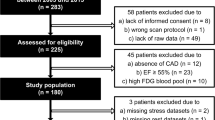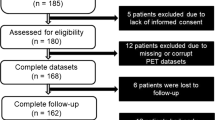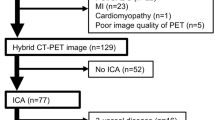Abstract
Background
We sought to evaluate the predictive value of positron emission tomography (PET) by using blood flow imaging with semiquantitative data analysis techniques for predicting recovery of regional function after revascularization. Positron emission tomography in combination with fluorodeoxyglucose (FDG) has been shown to predict tissue recovery after revascularization. Previous studies have suggested a quantitative threshold for perfusion as evaluated by PET that separates scar from viable tissue.
Methods and Results
In a group of 25 patients with impaired regional wall motion at baseline as measured by radionuclide ventriculography, we examined the relationship between myocardial blood flow and functional outcome of myocardial segments in patients who underwent coronary revascularization within 2 months after PET. Regional wall motion was graded on a 5-point scale, from normal to dyskinetic. Regional nitrogen 13 (N-13) ammonia uptake values were expressed as a percentage of maximal myocardial N-13 ammonia uptake and compared with values obtained from healthy volunteers. Results were displayed as polar maps, on which regions of interest were placed corresponding to revascularized vascular territories. We were able to show a statistically significant relationship between regional wall motion abnormalities and decreasing blood flow by N-13 ammonia uptake. An N-13 ammonia uptake of greater than 80% for any given segment was highly accurate in predicting normal or nearly normal postoperative regional wall motion, whereas severely decreased ammonia uptake less than 40% showed normalization of regional wall motion in only 13% of segments.
Conclusions
Relative ammonia uptake of greater than 80% and less than 40% preoperatively had excellent predictive value for functional outcome, but intermediate quantitative ammonia uptake (between 40% to 80%) necessitates additional information to accurately predict functional recovery
Similar content being viewed by others
References
Gotto AM, Farmer JA. Risk factors for coronary artery disease. In: Braunwald E, ed. Heart disease: a textbook of cardiovascular medicine. Philadelphia: WB Saunders, 1988: 1153.
Alderman EL, Fisher LD, Litwin P, et al. Results of coronary artery surgery in patients with poor left ventricular function. Circulation 1983;68:785–95.
Bounous EP, Mark DP, Pollock GP, et al. Surgical survival benefits for coronary artery disease in patients with left ventricular dysfunction. Circulation 1988;78:151–7.
Braunwald E, Rutherford JD. Reversible ischemic left ventricular dysfunction: evidence for the “hibernating myocardium”. J Am Coll Cardiol 1986;8:1467–70.
Vatner SF. Correlation between acute reductions in myocardial blood flow and function in conscious dogs. Circ Res 1980;47:201–7.
Schwaiger M, Hicks R. The clinical role of metabolic imaging of the heart by positron emission tomography. J Nucl Med 1991;32:565–78.
Schwaiger M, Muzik O. Assessment of myocardial perfusion by PET. Am J Cardiol 1991;67:35D-43D.
Stewart RE, Schwaiger M, Molina E, et al. Comparison of rubidium-82 positron emission tomography and thallium-201 SPECT imaging for detection of coronary artery disease. Am J Cardiol 1991;67:1303–10.
Beanlands RS, deKemp R, Scheffel A, et al. Myocardial viability determination using N-13 ammonia kinetics and PET. Circulation 1993;88:1–199.
Gewirtz H, Fischman AJ, Abraham S, Gilson M, Strauss W, Alpert NM. Positron emission tomographic measurements of absolute regional myocardial blood flow permits identification of nonviable myocardium in patients with chronic myocardial infarction. J Am Coll Cardiol 1994;23:851–9.
Grandin C, Melin JA, Essamri JL, et al. Prediction of functional improvement with PET in patients recovering from acute anterior ischemia. J Nucl Med 1991;32:1012.
Rothley J, Shaw L, Betley A, et al. Techniques for patient position in cardiac PET (positron emission tomography) studies. J Nucl Med Technol 1990;18:134.
Laubenbacher C, Rothley J, Sitomer J, et al. New automated analysis program for the evaluation of cardiac PET studies: initial results in the detection and localization of coronary artery disease using N-13 ammonia. J Nucl Med 1993;34:968–78.
Garcia EV, Van Train K, Maddahi J, et al. Quantification of rotational Thallium-201 myocardial tomography. J Nucl Med 1985;26:17–26.
Vignola P, Boucher C, Cuffman G. Abnormal interventricular septal motion following cardiac surgery clinical, surgical, echocardiographic, and radionuclide correlates. Am Heart J 1979;97:27–34.
vom Dahl J, Eitzman DT, AI-Aouar ZR, et al. Relationship of regional function, perfusion and metabolism in patients with advanced coronary artery disease undergoing surgical revascularization. Circulation 1994;90:2356–66.
Vanoverschelde JJ, Melin JA, Bol A, et al. Regional oxidative metabolism in patients after recovery from reperfused anterior myocardial infarction. Circulation 1992;85:9–21.
Porenta G, Kuhle W, Czernin J, et al. Semiquantitative assessment of myocardial blood flow and viability using polar map displays of cardiac PET images. J Nucl Med 1992;33:1623–31.
Tillisch J, Brunken R, Marshall R, et al. Reversibility of cardiac wallmotion abnormalities predicted by positron tomography. N Engl J Med 1986;314:884–8.
Author information
Authors and Affiliations
Corresponding author
Additional information
This work was performed during the tenure of an established investigatorship of the American Heart Association, Dallas, Texas (M. Schwaiger).
Supported in part by the National Institutes of Health, Bethesda, Md. (RO1 HL41047-02, and RO1 HL47543-01), by the Nuklearmedizinische Klinik und Poliklinik der Technischen Universitat Munchen, Klinikum rechts der Isar, Munchen, Germany, (C. Laubenbacher), and by the Division of Cardiology at the University of Aachen, Germany, (J. vom Dahl).
Rights and permissions
About this article
Cite this article
Duvernoy, C.S., vom Dahl, J., Laubenbacher, C. et al. The role of nitrogen 13 ammonia positron emission tomography in predicting functional outcome after coronary revascularization. J Nucl Cardiol 2, 499–506 (1995). https://doi.org/10.1016/S1071-3581(05)80042-X
Received:
Accepted:
Issue Date:
DOI: https://doi.org/10.1016/S1071-3581(05)80042-X




